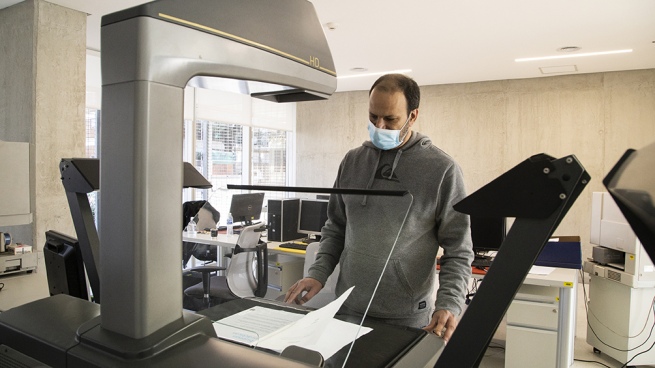From the time when documents were kept in envelopes and recorded by hand in files to the current process of digitalization and dissemination of a collection that is up to 400 years old, the General Archive of the Nation (AGN) works to safeguard history of the country and in democratizing its access, notably accelerated by social networks, highlighted its director, Paul Fontdevilawithin the framework of World Archives Daywhich is commemorated this Thursday.
An unpublished sound record of the poet Alfonsina Storni, the collection of one of the first photography houses in the country, and a historical film of the crowd that attended the wake of former President Hipólito Yrigoyen are some of the most “treasured” records of this national archive.
However, far from what is usually believed, in the AGN not only the memories of great Argentine heroes are preservedbut also -and mostly- memories of popular figures and the daily life of ordinary people, in a collection that brings together both public documents and private funds.
This organization, in addition to being “custodian of the documents that have to do with the history, memory and rights of the Argentine people”, has the mission of guaranteeing access to and dissemination of this historical documentation.
“Dissemination is a task that assumes an increasingly important role, which is added to the usual tasks of filers”, Fontdevila explained.
The digitization works in the General Archive of the Nation. (Photos: Leo Vaca).
In dialogue with Télam, the director of the AGN recalled that classically “The archives were consulted in person by specialists, historians, researchers and intellectuals who delved into the past”.
Increasingly, however, what was always a “specialist niche” draws attention and “arouses great curiosity” in the general public, based on social media posts, especially photos and videos.
“Paisano singing to his china next to the Monument to the Herdsman in the Mataderos neighborhood, 1939”reads an epigraph of one of the photos labeled “romantic”, which integrates a countless number of photographs of various themes, such as urban planning, workers, Argentine industry, artists, athletes, police, popular, curiosities, architecture and advertisements.
“In general, it seems to me that the past has a particular appealperhaps due to the vertiginousness that time has in the change of technologies, supports and culture as well”, Fontdevila expressed and added: “This contrast generates enormous curiosity and is reflected in the presence that the archive has on the networks” .
On June 9, 1948, UNESCO established the creation of the International Council on Archives, with the aim of defending the protection and conservation of documentary heritage. Since 2008, that date has been International Archives Day.
“Archiving is going through a good time and it will be strengthened with the incorporation of technology that allows it to conserve, classify and better access the general public, which is the objective imposed on us by the law on access to public information, to facilitate Argentine people the knowledge of history,” assured the head of the organization.

Those documents, the oldest are over 400 years oldare in different formats: on paper, photographic paper, photography on glass, audio, video and its different versions such as acetate film, vinyl and tapes of different compositions, which “tell the history of these technologies”.
As for its preservation, this constellation of archives is subject “to all the unknowns generated by the vertiginous evolution of technology.”
“We began to notice that there are CD’s that we can no longer readthere are cassettes that we don’t have the means to reproduce them with and that these supports are very quickly forgotten and are losing access possibilities,” Fontdevila pointed out, adding that the objective is “to guarantee their conservation in the midst of a systematic migration process,” starting which is passed from one generation of technology to the next constantly.
Likewise, the director of the AGN highlighted that digitization facilitated access to the three services most requested by the general population: immigration registration certificates, to process dual nationality; ancient decrees; estates and deeds; and judicial documents, requested for large processes such as the trial for the Napalpí massacrein which material preserved there was contributed, in an enormous opportunity to show that “there is a preservation of rights in addition to documents”.
In this line, he highlighted the different emerging experiences of “popular archives”, which also suppose a custody of the history and the rights of specific communities, such as the Trans Memory Archive or the Popular Memory Archivewhich recovers the history of the Papa Francisco neighborhood (former Villa 20), in Lugano.
“These experiences go hand in hand with the conquest of real rights in society, because those who were made invisible not only could not have an archive but also could not even express themselves freely through the various alternatives of expression,” Fontdevila concluded.


















